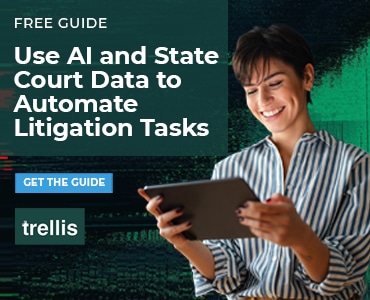Dean Whalen, Chief Legal Officer of Readback, a new AI-assisted deposition court reporting platform, explains how AI-assisted court reporting addresses the stenographer talent crunch — with added benefits. Updated for 2025.

Table of contents
When I wrote about the rise of AI-assisted deposition reporting in 2022, the technology was still seen by many as a novel solution to the escalating stenographer shortage. Now, in 2025, that reality has hit home hard: the shortage is worse than ever, pushing costs higher and creating scheduling bottlenecks that directly impact a lawyer’s ethical duty of competence and diligence.
What was once a “nice-to-have” efficiency tool is now a strategic necessity. For forward-thinking litigation practices, AI-assisted court reporting has moved beyond simple transcription to become a core tool for real-time case strategy and demonstrable client value.
The transition is happening rapidly, and my warning about the “Blockbuster Analogy” is more apt than ever. Firms that cling solely to outdated, capacity-limited methods will find themselves unable to compete with those leveraging technology.
Here are the three primary ways AI-assisted court reporting improves the client experience by providing a competitive edge today.
1. Improved Client Outcomes: Real-Time Strategic Advantage
In 2022, the selling point was that the hybrid AI-and-human model produced a higher-accuracy transcript (up to 98.5%) than traditional methods. In 2025, that accuracy is a given, but the real game-changer is speed and analytical insight.
We’ve shifted from simply viewing the transcript as a record to using it as a live strategy tool:
- Near-Instant Access: You no longer wait days or weeks for a certified transcript. With modern AI-assisted court reporting, attorneys receive a near-real-time draft transcript that can be reviewed and annotated during the deposition or hearing.
- Contradiction Flagging: The best systems integrate Natural Language Processing (NLP). This means the system doesn’t just type the words; it analyzes them. In a high-stakes deposition, an AI can instantaneously flag a potential inconsistency with a previous statement or document, allowing counsel to pivot their questioning in real-time. This is about making a better record in the moment—a direct and tangible improvement to the client’s outcome.
2. An Improved Pace of Justice: Seamless Workflow Integration
My original point focused on meeting the ABA’s mandate to expedite litigation (Model Rule 3.2) by offering faster transcripts. Today, AI’s contribution to the pace of justice is far more profound: it eliminates the administrative lag that bogs down litigation.
The real innovation in modern AI-assisted court reporting is its ability to integrate the data into your team’s workflow:
- Generative Summaries: Once a proceeding is complete, AI doesn’t just deliver the text; it can produce an Executive Summary or a Chronology of Key Events almost instantly. This saves your associates and paralegals countless hours of non-billable time summarizing hundreds of pages. That reclaimed time is spent on actual analysis and strategy.
- Searchable Ecosystems: The transcript is delivered as a fully searchable, digital, time-stamped file that seamlessly integrates with your existing case management and e-discovery platforms. Instead of manually cross-referencing a printed document, you can search across every deposition in a complex case and locate key testimony within seconds. Efficiency at this level is a strategic advantage.
3. Eliminating Fees, Fees, Fees: Transparency and Predictable Pricing
The shortage in stenography has driven prices up, made specialized services like real-time reporting cost-prohibitive, and often resulted in hidden fees. AI-assisted court reporting forces market competition that benefits the client.
- Flat-Rate Certainty: The flat-rate or low-cost subscription model of most AI providers remains the antidote to the unpredictable, high-premium pricing of traditional stenography.
- Cost-Effective Remote Proceedings: The technology fully supports high-quality, secure remote depositions. This eliminates ancillary costs like travel, venue rental, and per-mile fees—overhead the client should no longer be expected to bear. By reducing the overall cost footprint of discovery, AI-assisted court reporting provides transparent, defensible billing that strengthens the attorney-client relationship.
The 2025 Mandate: Competence and Security
With the widespread adoption of AI, a new layer of professional responsibility has emerged that every litigator must address.
The question is no longer whether your firm can afford to use AI, but whether you can afford not to. ABA Model Rule 1.1 dictates that a lawyer must provide competent representation, and in 2025, that includes technological competence. Your clients are likely already using AI in their own businesses and expect you to use the most efficient, accurate, and cost-effective tools available.
However, you must exercise due diligence:
- Confidentiality: Given the sensitive nature of testimony, your primary concern must be data security. You need assurances that the AI-assisted court reporting provider offers enterprise-grade encryption and secure storage compliant with all relevant data privacy laws.
- Hybrid Model is Non-Negotiable: Never accept a purely machine-generated transcript for an official record. The hybrid model—AI capturing the speech, and a professional human reviewer certifying the transcript—is the ethical and professional standard required to ensure the integrity and admissibility of the final document.
The future of court reporting is a hybrid of human expertise and scalable technology. By embracing a modern AI-assisted court reporting solution, you are not just solving a logistical problem; you are delivering a higher quality, more strategic, and more cost-effective service to your client.
Illustration ©iStockPhoto.com
Subscribe to Attorney at Work
Get really good ideas every day for your law practice: Subscribe to the Daily Dispatch (it’s free). Follow us on Twitter @attnyatwork.















